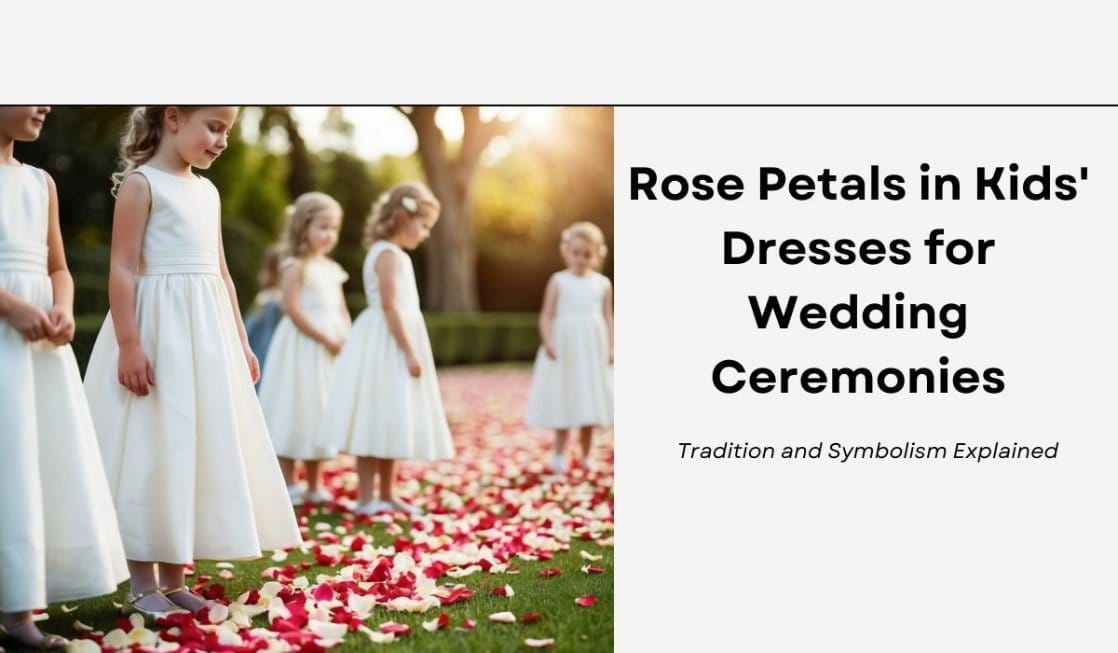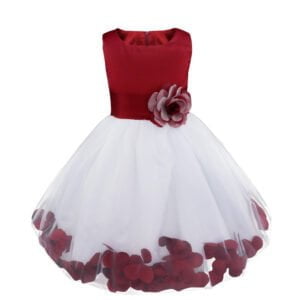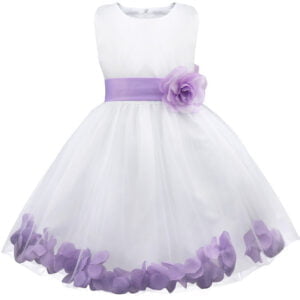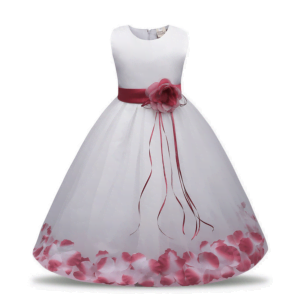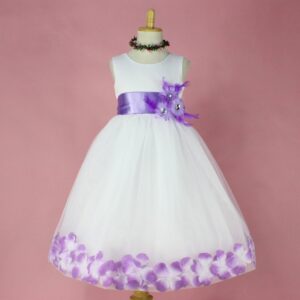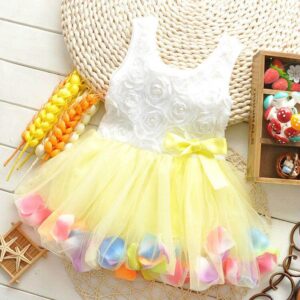From Flower Girls to Fashion: The Timeless Romance of Petal-Adorned Children’s Attire
Rose petals have long been a beloved element in wedding ceremonies, adding a touch of romance and beauty to the occasion. Children often play a special role in these events, scattering petals as they walk down the aisle. Kids’ dresses adorned with rose petals can create a charming and magical atmosphere, enhancing the overall aesthetic of the wedding day.
The tradition of flower girls dates back to Victorian times, when young girls would carry baskets of fresh flowers to guide the bride towards her future husband. Today, this custom has evolved, with many brides opting to incorporate rose petals into the flower girls’ attire. This not only adds a lovely visual element but also gives children a sense of importance and involvement in the ceremony.
On This Page
Key Takeaways
- Rose petals in kids’ dresses add a romantic touch to wedding ceremonies
- Flower girl traditions have evolved from Victorian times to modern interpretations
- Incorporating children in weddings creates a sense of family unity and involvement
History of Flower Girls
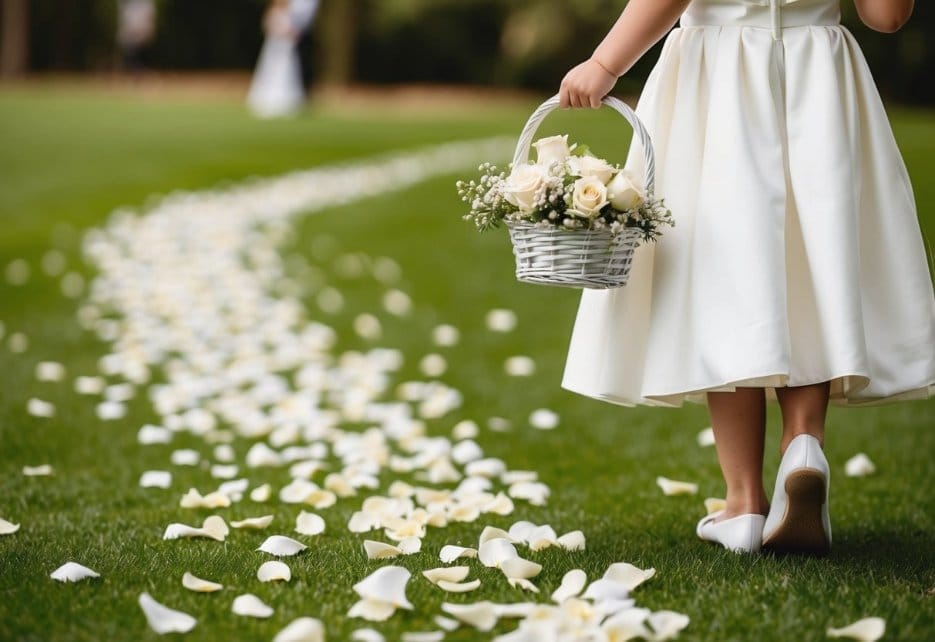
Flower girls have played a charming role in weddings for centuries. Their presence adds innocence and beauty to the ceremony, with traditions evolving over time.
Ancient Traditions
The custom of flower girls dates back to ancient Rome. Young girls would carry wheat and herbs down the aisle, symbolising fertility and new beginnings. In medieval times, flower girls scattered rose petals to create a fragrant path for the bride.
During the Elizabethan era, flower bearers took on more elaborate roles. They would follow musicians in the wedding procession, carrying silver cups adorned with ribbons. These cups often contained rose petals or sweet-smelling herbs.
Evolution of the Role in Weddings
The Victorian era saw flower girls take on a role more familiar to modern weddings. They began wearing white dresses to match the bride, symbolising purity and innocence.
In today’s ceremonies, flower girls typically walk down the aisle scattering petals. Their dresses often complement the bride’s gown and the overall wedding theme. The flower girl’s role now represents youthful charm and the promise of new beginnings.
Some modern couples are putting creative twists on the tradition. Flower girls might carry small bouquets, blow bubbles, or even lead beloved pets down the aisle. These variations keep the spirit of the custom alive while adding personal touches to the ceremony.
Role and Significance of Rose Petals
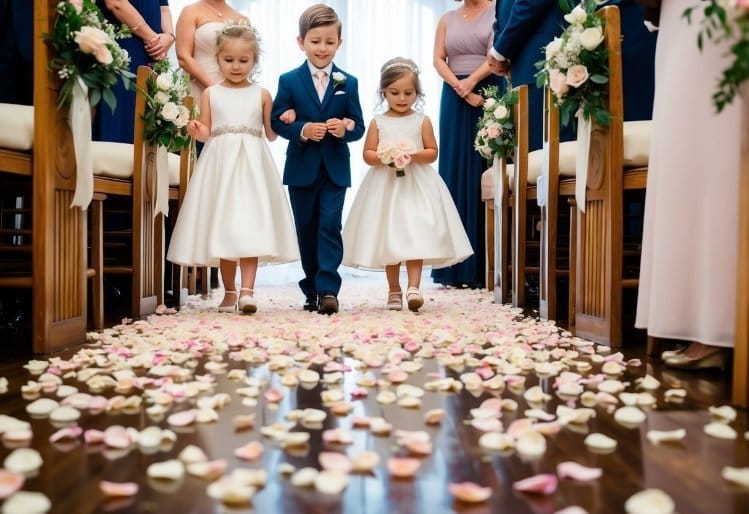
Rose petals play a meaningful part in wedding ceremonies. They bring beauty and symbolism to children’s dresses and the overall event.
Symbolism of Rose Petals
Rose petals represent love and purity in weddings. For kids’ dresses, they add a touch of innocence. Red petals stand for passion, while white ones mean purity.
Some believe rose petals ward off evil spirits and bring good luck. This ties into old ideas about protecting the bride and groom.
Rose petals are also linked to fertility. This fits with the idea of new life and family that weddings celebrate.
Cultural Importance
Many cultures value rose petals in ceremonies. In some places, guests toss petals for good fortune.
Indian weddings often use rose petals in colourful designs. These patterns have special meanings.
In the UK, flower girls may scatter rose petals. This sweet act is meant to bring joy to the couple’s path.
Rose petals on kids’ dresses add a festive touch. They make the young attendants feel special and part of the day.
Flower Girl Duties and Traditions
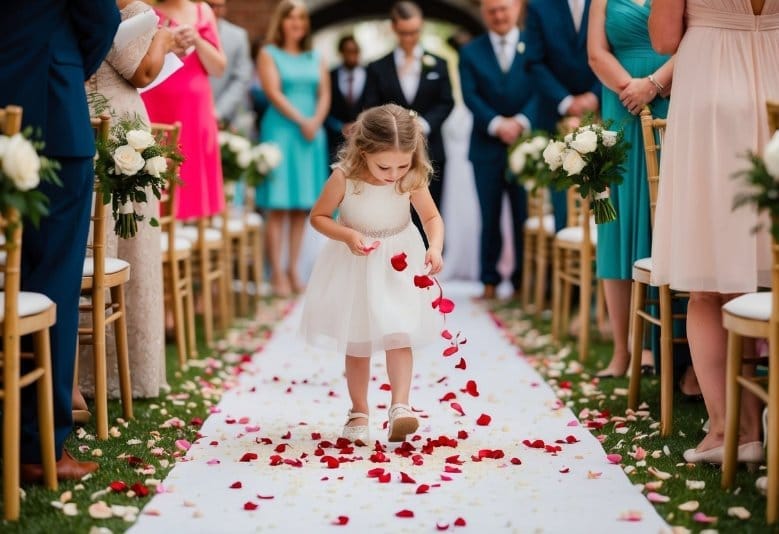
The flower girl plays a special role in weddings. She walks down the aisle before the bride, scattering petals. Her duties are simple but meaningful.
The Processional
The flower girl walks down the aisle just before the bride. She often follows the bridesmaids. Her main job is to scatter rose petals or other flowers along the path.
Some flower girls carry a small basket filled with petals. Others might use a wand or pomander instead. The flower girl’s walk sets a sweet tone for the bride’s entrance.
Flower girls are usually young, often between 3 and 8 years old. They wear dresses that match or complement the wedding colours.
Duties During the Ceremony
Once at the altar, the flower girl’s formal duties are done. She usually stands with the bridesmaids during the ceremony. Some couples ask her to hold a small posy or their rings.
The flower girl might need to sit with her parents if she’s very young. This depends on the length of the ceremony and the child’s age.
After the ceremony, she often joins the wedding party for photos. She may also take part in the reception, perhaps joining a first dance or cake-cutting.
Selecting Flower Girl Dresses
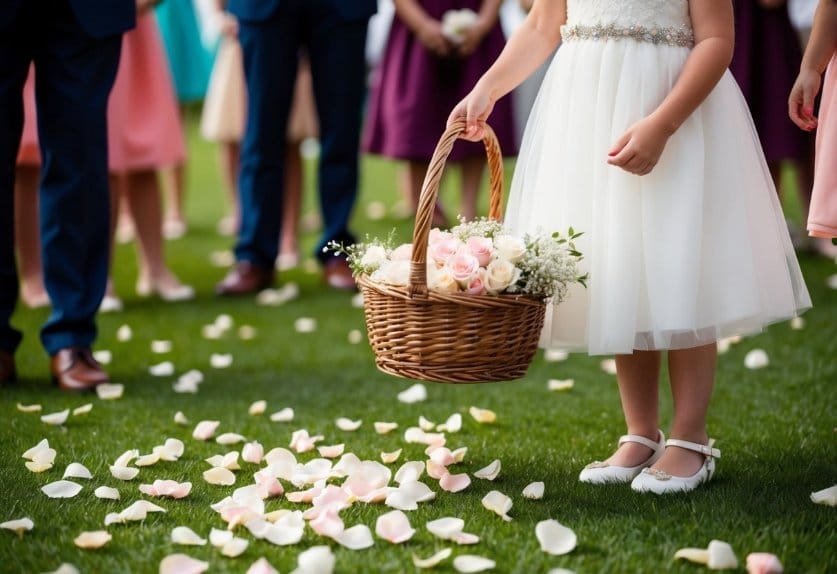
Choosing the perfect flower girl dress is an important part of wedding planning. The right dress can make young attendants feel special and complement the overall wedding style.
Dress Styles for Young Bridesmaids
Flower girl dresses come in various styles to suit different wedding themes. A-line dresses are popular for their flattering fit on most body types. Ball gowns offer a fairy tale look with full skirts.
Tea-length dresses strike a balance between formal and playful. For a more casual wedding, knee-length dresses are a practical choice.
Lace and tulle are common fabric choices that add elegance. Satin provides a smooth, polished appearance.
Colours often match or complement the bridesmaids’ dresses. White and ivory are classic choices, while pastel shades add a soft touch.
Flower Girl Dress Trends
Recent trends in flower girl fashion include bohemian styles with floral crowns and flowing fabrics. Vintage-inspired dresses with delicate embroidery are gaining popularity.
Some brides opt for two-piece outfits with a tutu skirt and separate top for a mix-and-match look. Sparkly details like sequins or beading add a touch of glamour.
Comfort is key for young attendants. Breathable fabrics and non-restrictive designs ensure girls can move freely during the ceremony and reception.
Consider the season when selecting dresses. Sleeveless styles work well for summer, while long sleeves or wraps are suitable for cooler months.
Coordinating with the Wedding Party
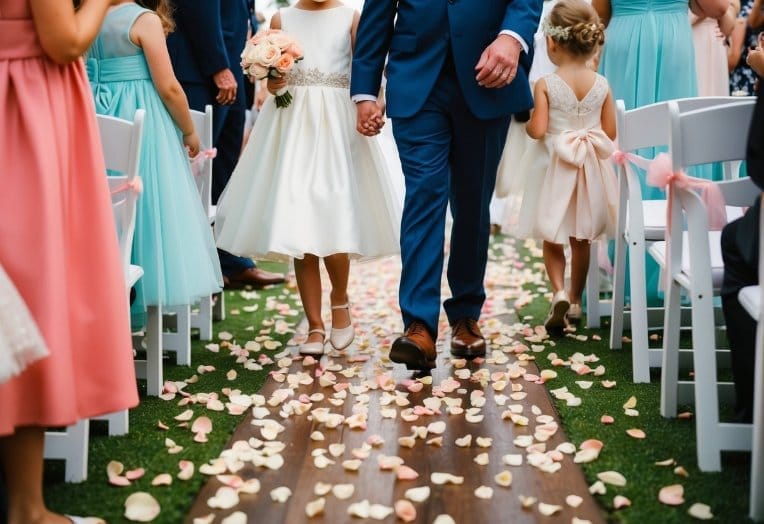
Coordinating flower girl outfits with the wedding party creates a cohesive look. It involves matching colours and styles while adding special touches for the young attendants.
Matching the Bridal Party
Flower girls often wear dresses that complement the bridesmaids’ attire. The colour scheme is crucial. Choose a shade that matches or coordinates with the bridal party’s dresses.
For a unified look, select fabrics similar to those used for adult gowns. Satin, tulle, or lace are popular choices. The length of the dress can vary, but tea-length or knee-length styles are common for young girls.
Consider the wedding’s formality when choosing the dress style. A ball gown silhouette suits formal affairs, while a simpler A-line dress works well for casual weddings.
Accessorising the Outfit
Accessories play a key role in tying the flower girl’s look to the bridal party. A sash in the wedding’s accent colour can add a pop of colour and coordinate with bridesmaids’ dresses.
Floral elements are essential. Flower girls might carry small posies or wear flower crowns that match the bridesmaids’ bouquets. For a modern twist, consider a wrist corsage or a floral basket.
Shoes should be comfortable and age-appropriate. Ballet flats or Mary Janes in a colour that matches the dress work well. For outdoor weddings, consider sturdy sandals.
Don’t forget hair accessories. Ribbons, clips, or small tiaras can complement the bridal party’s hairstyles while being suitable for young girls.
Rose Petals in Children’s Wedding Fashion
Rose petals add a whimsical touch to children’s wedding attire. They bring colour and charm to flower girl dresses and accessories. Let’s explore how these delicate blossoms enhance kids’ wedding fashion.
Incorporating Floral Elements
Rose petals feature in many aspects of flower girl outfits. Dresses often have petals sewn onto the skirt or bodice, creating a fairy-tale look. Some frocks have petal-shaped layers, mimicking a blooming rose.
Accessories also embrace the floral theme. Headbands and hair clips adorned with fabric rose petals are popular choices. Baskets lined with petals complete the ensemble, ready for scattering down the aisle.
Shoes get the petal treatment too. Some have small roses attached, while others feature petal-shaped cutouts or embroidery.
Modern Interpretations
Today’s designers are finding fresh ways to use rose petals in kids’ wedding wear. Instead of sewn-on petals, some dresses have petal-inspired textures or prints. This creates a subtle nod to tradition.
Colour palettes have expanded beyond classic white and pink. Ombré effects with gradual petal shades are gaining popularity. Some designers use metallic petals for a touch of glamour.
Eco-friendly options are emerging too. Biodegradable petals made from plant-based materials offer a sustainable choice for scatter baskets. These align with the growing trend of green weddings.
Recommended products
Flower girl dress with rose petals inside – Dark Red
£26.99Flower girl dress with sash – Lavender
£26.99Long flower girl dress with sash – Red
£21.99Long flower girl dress with sash – Lilac
Original price was: £26.99.£18.99Current price is: £18.99.Cute baby girl summer dress – Yellow
£13.99
The Social Aspect of Flower Girls
Flower girls play a unique social role in wedding ceremonies. They interact with guests and have a special place in the wedding party.
Interaction with Guests
Flower girls often charm wedding guests with their cuteness and innocence. Their presence adds a joyful atmosphere to the ceremony. Many guests enjoy watching the little ones walk down the aisle, scattering rose petals along the way.
Flower girls sometimes greet guests before the ceremony starts. They might hand out programmes or confetti. This helps them feel important and involved in the big day.
During the reception, flower girls may dance with guests or pose for photos. Their playful energy can help break the ice and get people mingling.
Role in the Wedding Party
Flower girls are junior members of the bridal party. They often form bonds with other children in the wedding, like the ring bearer or junior groomsmen.
The bride may spend time with the flower girl before the ceremony. This can help calm nerves and create special memories. Some brides give their flower girls small gifts to show appreciation.
Flower girls sometimes join in getting ready with the bridesmaids. They might have their hair and makeup done, making them feel grown-up and special.
During formal photos, flower girls are usually included with the main wedding party. This highlights their important role in the celebration.
Frequently Asked Questions
Rose petals play a special role in wedding ceremonies. They add beauty and meaning to the event. Children often take part by scattering petals as flower girls.
What is the significance of flower girls in wedding ceremonies?
Flower girls are a sweet tradition in many weddings. They represent innocence and hope. The sight of a young girl tossing petals brings joy to guests.
Flower girls also symbolise new beginnings. Their presence adds charm to the ceremony.
At what age is a child typically too old to act as a flower girl?
Most flower girls are between 3 and 8 years old. By age 10, many girls feel too old for the role.
It’s best to choose a child who is comfortable with the task. Very young toddlers may struggle to walk down the aisle alone.
What are some alternative roles or activities for flower girls who do not throw petals?
Some flower girls carry a small bouquet or a basket of flowers. Others might hold a sign or blow bubbles.
Older girls could be junior bridesmaids. Younger ones could hand out programmes or confetti to guests.
Can rose petals cause stains on wedding dresses, and how can this be avoided?
Fresh rose petals can stain light fabrics. To prevent this, use dried petals or silk ones.
Another option is to choose petals in light colours. These are less likely to leave marks on dresses.
What does the tradition of dropping rose petals at weddings symbolise?
Rose petals represent love and beauty. Scattering them creates a path of romance for the bride.
This custom also wishes the couple good fortune. It’s meant to ensure a happy life together.
How does the presence of rose petals enrich the theme of a wedding ceremony?
Rose petals add colour and texture to the venue. They create a romantic atmosphere.
Petals can match the wedding colours. This helps tie the whole look together and makes photos more beautiful.
Related Post: What Are Rose Petals and How They Are Made: A Brief Guide to Nature’s Delicate Creations

